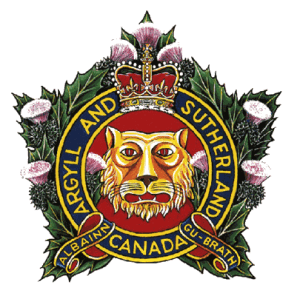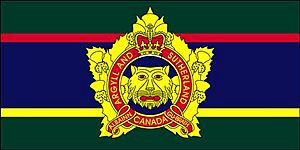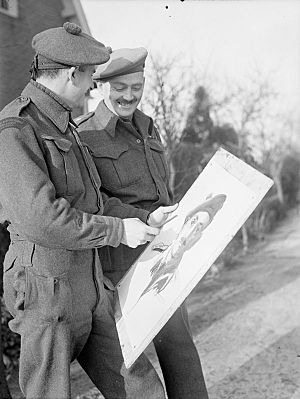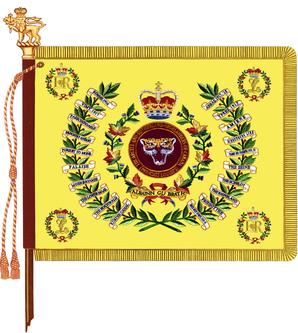Argyll and Sutherland Highlanders of Canada (Princess Louise's) facts for kids
Quick facts for kids The Argyll and Sutherland Highlanders of Canada (Princess Louise's) |
|
|---|---|

Cap badge of the Argyll and Sutherland Highlanders of Canada
|
|
| Active | 1903–present |
| Country | Canada |
| Branch | Canadian Army |
| Type | Light Infantry |
| Role | To close with and destroy the enemy |
| Size | 1 battalion |
| Part of | 31 Canadian Brigade Group |
| Garrison/HQ | Hamilton |
| Nickname(s) | The Argylls |
| Motto(s) | Scottish Gaelic: Albainn gu brath (Scotland forever) |
| March | Quick: "The Campbells Are Coming" |
| Engagements | First World War War in Afghanistan |
| Battle honours | See #Battle honours |
| Commanders | |
| Current commander |
Lieutenant-Colonel Carlo Tittarelli, CD |
| Colonel-in-chief | Vacant |
| Insignia | |
| Tartan | Sutherland |
The Argyll and Sutherland Highlanders of Canada (Princess Louise's), often called the A & SH of C or "The Argylls," is a special kind of army unit. It's a Primary Reserve Highland infantry regiment in the Canadian Forces. This means its soldiers are part-time and train to be ready if needed. The regiment is based in Hamilton, Ontario, at the John W. Foote VC Armoury.
Contents
How the Regiment Started
The idea to create a full Highland regiment in Hamilton began with members of the St. Andrew's Society and the Sons of Scotland. These groups celebrated Scottish heritage. In late 1902, they held meetings and asked important people in the city's Scottish-Canadian community to help make it happen.
James Chisholm and William Logie, who was a captain in another regiment, led the effort. They gathered support from local Scottish groups and sent a request to the Minister of Militia. The minister, Frederick Borden, wasn't very excited about the cost or the idea of a Highland unit with its unique uniforms. He wanted all militia units to look the same.
But Hamilton's Scottish-Canadian leaders quickly found officers and raised money to buy the special Highland uniforms. They gathered over 700 names of people who wanted to join. These were often Scottish men who owned their homes and were important in the community. Chisholm and Logie kept pushing the government. In the end, their hard work paid off.
The regiment was officially formed on September 13, 1903. It was first known as the 91st Regiment Canadian Highlanders.
Regimental History
Early Days
After the regiment was formed, James Chisholm and William Logie continued to work hard for it. They often went straight to the minister to solve problems, which was unusual. For example, when the British Argylls sent the 91st a special snuff box, customs wanted to charge a tax. Logie and Chisholm got their Member of Parliament to help, and a solution was found.
Chisholm became the regiment's paymaster in 1903. The regiment became a huge part of his life. Logie was the first commanding officer until 1911. Their office even served as a second headquarters for the battalion. Chisholm also took a special interest in the Pipe Band. The regiment also offered a lively social life with dinners and events.
The Great War
During the First World War, the regiment helped train soldiers. It sent many officers and soldiers to other Canadian battalions fighting overseas. The most important connection was with the 19th Battalion. The 91st provided all four of its commanding officers and its famous Pipe Major, Charles Davidson Dunbar.
The 19th Battalion fought in many major battles in France and Belgium. These included Saint-Eloi in 1916, the Somme, Courcelette, Vimy Ridge, Hill 70, Passchendaele, and the Pursuit to Mons. In December 1918, after the war ended, the battalion's Pipe Band led the victorious Canadian troops into Germany.
Victoria Cross Recipient
Lieutenant Hugh McKenzie was awarded the Victoria Cross after he died in battle. This is the highest award for bravery in the British Commonwealth. He earned it for his actions during the Battle of Passchendaele on October 30, 1917.
McKenzie was leading a machine gun team. When he saw that some soldiers were struggling to advance because of enemy machine gun fire, he took charge. He organized an attack and captured the enemy position. But then he saw another enemy position nearby that was also firing. Lieutenant McKenzie led another attack, but he was killed during the fight. He had already won other awards for his bravery before this.
Between the Wars
After the First World War, the regiment continued its role as a reserve unit. Many veterans from the war joined, keeping the regiment strong. It was well-known in the community, with weekly parades and active bands (pipe, brass, and bugle).
The Second World War
Before the Second World War officially began, parts of the regiment were called to duty in August 1939. They guarded local canals and power stations. The main battalion, the 1st Battalion, was formed in June 1940. At first, they had old uniforms and weapons.
- Niagara
The first months of the war were spent guarding the Welland Canal and power facilities near Niagara-on-the-Lake. There was little training and new equipment was slow to arrive.
- Jamaica
From September 1941 to May 1943, the battalion was stationed in Jamaica. They learned about the harsh realities of war from the experiences of other Canadian units. Under Lieutenant-Colonel Ian Sinclair, the unit received new weapons and improved its training.
- England
The 1st Battalion returned to Hamilton in May 1943. They then moved to England to prepare for fighting overseas. Acting Sergeant John Rennie bravely gave his life in October 1943 during training, shielding others from an exploding grenade. He was awarded the George Cross for his courage. The unit trained hard, preparing for battle.
- Normandy
The Argylls first saw major action in August 1944, fighting their way towards Falaise in France. In one impressive action, their commander, Lieutenant-Colonel J. David Stewart, led the battalion through enemy lines at night to capture a strong enemy position called Hill 195. Later, during the Falaise Gap battle, a group of Argylls and tanks captured St Lambert-sur-Dives and held it for three days against strong enemy attacks.
A soldier named Cpl H. E. Carter wrote home about the fighting: "That life in the front is not fun, not glamorous — it's dirty, and fierce and anyone that says they're not scared is crazy." But he also noted how soldiers kept their spirits up and joked even under fire.
- The Scheldt
The Argylls continued to fight through difficult battles, including the intense fighting in the Scheldt area of the Netherlands.
- Friesoythe
During the final stages of the war, in April 1945, the Argylls were involved in the battle for Friesoythe. Their popular commanding officer, Lieutenant-Colonel F.E. Wigle, was killed in action. This led to a difficult situation where a large part of the town was destroyed.
- Overall
The Argylls fought successfully against the enemy through many battles, from Moerbrugge and the Scheldt to Friesoythe and the Küsten Canal. Despite heavy losses (267 killed and 808 wounded), they were known for their strong spirit and effectiveness in battle.
After the war, the 1st Battalion represented the Canadian Armed Forces in victory celebrations in Berlin in July 1945. They returned to Hamilton in January 1946.
After the War
After the Second World War, the regiment returned to its role as a reserve unit. Over the years, military policies changed, but the Argylls continued to serve Canada. They helped with natural disasters at home, like the 1998 ice storm and the Red River flood. They also supported UN and NATO missions abroad. Since the 1950s, Argylls have been deployed to places like Cyprus, Germany, Bosnia, Kosovo, and Afghanistan.
War in Afghanistan
Between 2002 and 2014, many soldiers from the Argylls volunteered to serve in Afghanistan. More than 20% of the regiment's strength contributed to these missions.
Community Support
The Argylls have a strong connection with their local community. Groups like the 91st Highlanders Athletic Association and events like the annual Greater Hamilton Tattoo show this support.
The city of Hamilton has honored the Argylls in many ways. In 1972, they were given the "freedom of the city." The Ontario government has placed special plaques on the Armoury walls to honor two Argyll soldiers. The regiment also has a close link with Central Presbyterian Church. Local businesses and foundations have also generously supported the regiment, helping to publish a pictorial history of the Argylls in the Second World War.
National War Memorial Attack
On October 22, 2014, Corporal Nathan Cirillo of the Argylls was tragically killed while standing guard at the National War Memorial (Canada) in Ottawa. He was performing his ceremonial duty when he was attacked.
Pipes & Drums
The regiment has a famous Pipes & Drums band. They have performed across Canada and internationally. They have appeared five times at the well-known Royal Edinburgh Military Tattoo in Scotland, most recently in 2012.
A special bagpipe tune called 'Lament for the Argylls' was composed in honor of the regiment by Major Archie Cairns. He was the Pipe Major in the 1950s, and his father was also a piper in the 19th Battalion during the First World War.
Past Pipe Majors and Pipe Officer
The Argyll and Sutherland Highlanders of Canada (Princess Louise's) (1903–present)
- Pipe Major A.M. MacGregor, 1903–1913
- Pipe Major Charles Davidson Dunbar, DCM, 1913–1917
- Pipe Officer (Lieut) Charles Davidson Dunbar, DCM, 1917–1937
- Pipe Major S. Featherstone, 1923–1940
- Pipe Major J.K. Cairns, 1946–1949
- Pipe Major J. Wilson, 1949–1952
- Pipe Major A. Cairns, 1952–1954
- Pipe Major C. Wright, 1954–1956
- Pipe Major A. Craig, CD, 1957–1963
- Pipe Major W. Day, CD, 1963–1965
- Pipe Major G. Henderson, CD, 1965–1973
- Pipe Major J. Terence, MMM, CD, 1973–2000
- Pipe Major T.G. Lee, CD, 2000–2010
- Pipe Major S. Balinson, CD, 2010–Present
19th Battalion, CEF (1914–1919)
- Pipe Major C.D. Dunbar, DCM, 1915–1916
- Pipe Major S. Featherstone, 1916–1919
1st Battalion (1940–1946)
- Pipe Sergeant P.C. McGinlay, 1940
- Pipe Sergeant F. Noble, 1940
- Pipe Major F. Noble, 1940–1946
2nd Battalion (1940–1946)
- Pipe Major S. Featherstone, 1940–1946
Regimental Tartan

The Argyll and Sutherland Highlanders wear a kilt with a specific tartan pattern. This pattern is very similar to the "Black Watch" tartan, which is used by many military units across the Commonwealth. The kilts worn by the Argylls have a special "box pleat" style.
Headdress
The Glengarry hat worn by the Argylls is unique. It has red and white squares in its pattern, while most other Scottish and Highland units have black and red squares. This special pattern has been worn by the regiment and its related units for a very long time. However, regimental pipers in all Argyll-affiliated units wear plain black glengarries without this pattern.
Lineage
This section shows how the regiment's name and organization have changed over time.
The Argyll and Sutherland Highlanders of Canada (Princess Louise's)
- Started on September 1, 1903, as the 91st "Highlanders."
- Renamed on July 2, 1904, as the 91st Regiment Canadian Highlanders.
- Renamed on May 1, 1920, as The Argyll and Sutherland Highlanders of Canada.
- Renamed on October 15, 1920, as the Princess Louise's (Argyll and Sutherland Highlanders) of Canada.
- Renamed on June 15, 1927, as The Argyll and Sutherland Highlanders of Canada (Princess Louise's).
- Joined with the 3rd Machine Gun Battalion, CMGC (except 'C Company') on December 15, 1936, and renamed as The Argyll and Sutherland Highlanders of Canada (Princess Louise's) (Machine Gun).
- Renamed on November 7, 1940, as the 2nd (Reserve) Battalion, The Argyll and Sutherland Highlanders of Canada (Princess Louise's).
- Renamed on February 1, 1941, as the 2nd (Reserve) Battalion, The Argyll and Sutherland Highlanders of Canada (Princess Louise's).
- Renamed on February 15, 1946, as The Argyll and Sutherland Highlanders of Canada (Princess Louise's).
3rd Machine Gun Battalion, CMGC
- Started on June 1, 1919, as the 3rd Machine Gun Brigade, CMGC.
- Renamed on September 15, 1924, as the 3rd Machine Gun Battalion, CMGC.
- Joined with The Argyll and Sutherland Highlanders of Canada (Princess Louise's) on December 15, 1936 (except C Company).
Chart
| Lineage chart | |||||||||||||||||||||||||||||||||||||||||||||||||||||||||||||||||||||||||||||||||||||||||||||||||||||||||||||||||||||||||||||||||||||||||||||||||||||||||||||||||||||||||||||||||||||||||||||||||||||||||||||||||||||||||||||||||||||||||||||||||||||||||||||||||||||||||||||||||||||||||||||||||||||||||||||||||||||||||||||||||||||||||||||||||||||||||||||||||||||||||||||||||||||||||||||||||||||||||||||||||||||||||||||||||||||||||||||||||||||||||||||||||||||||||||||||||||||||||||||||||||||||||||||||||||||||||||||||||||||||||||||||||||||||||||||||||||||||||||||||||||||||||||||||||||||||||||||||||||||||||||||||||||||||||||||||||||||||||||||||||||||||||||||||||||||||||||||||||||||||||||||||||||||||||||||||||||||||||||||||||||||||||||||||||||||||||||||||||||||||||||||||||||||||||||||||||||||||||||||||||||||||||||||||||||||||||||||||||||||||||||||||||||||||||||||||||||||||||||||||||||||||||||||||||||||||||||||||||||||||||||||||||||||||||||||||||||||||||||||||||||||||||||||||||||||||||||||||||||||||
|---|---|---|---|---|---|---|---|---|---|---|---|---|---|---|---|---|---|---|---|---|---|---|---|---|---|---|---|---|---|---|---|---|---|---|---|---|---|---|---|---|---|---|---|---|---|---|---|---|---|---|---|---|---|---|---|---|---|---|---|---|---|---|---|---|---|---|---|---|---|---|---|---|---|---|---|---|---|---|---|---|---|---|---|---|---|---|---|---|---|---|---|---|---|---|---|---|---|---|---|---|---|---|---|---|---|---|---|---|---|---|---|---|---|---|---|---|---|---|---|---|---|---|---|---|---|---|---|---|---|---|---|---|---|---|---|---|---|---|---|---|---|---|---|---|---|---|---|---|---|---|---|---|---|---|---|---|---|---|---|---|---|---|---|---|---|---|---|---|---|---|---|---|---|---|---|---|---|---|---|---|---|---|---|---|---|---|---|---|---|---|---|---|---|---|---|---|---|---|---|---|---|---|---|---|---|---|---|---|---|---|---|---|---|---|---|---|---|---|---|---|---|---|---|---|---|---|---|---|---|---|---|---|---|---|---|---|---|---|---|---|---|---|---|---|---|---|---|---|---|---|---|---|---|---|---|---|---|---|---|---|---|---|---|---|---|---|---|---|---|---|---|---|---|---|---|---|---|---|---|---|---|---|---|---|---|---|---|---|---|---|---|---|---|---|---|---|---|---|---|---|---|---|---|---|---|---|---|---|---|---|---|---|---|---|---|---|---|---|---|---|---|---|---|---|---|---|---|---|---|---|---|---|---|---|---|---|---|---|---|---|---|---|---|---|---|---|---|---|---|---|---|---|---|---|---|---|---|---|---|---|---|---|---|---|---|---|---|---|---|---|---|---|---|---|---|---|---|---|---|---|---|---|---|---|---|---|---|---|---|---|---|---|---|---|---|---|---|---|---|---|---|---|---|---|---|---|---|---|---|---|---|---|---|---|---|---|---|---|---|---|---|---|---|---|---|---|---|---|---|---|---|---|---|---|---|---|---|---|---|---|---|---|---|---|---|---|---|---|---|---|---|---|---|---|---|---|---|---|---|---|---|---|---|---|---|---|---|---|---|---|---|---|---|---|---|---|---|---|---|---|---|---|---|---|---|---|---|---|---|---|---|---|---|---|---|---|---|---|---|---|---|---|---|---|---|---|---|---|---|---|---|---|---|---|---|---|---|---|---|---|---|---|---|---|---|---|---|---|---|---|---|---|---|---|---|---|---|---|---|---|---|---|---|---|---|---|---|---|---|---|---|---|---|---|---|---|---|---|---|---|---|---|---|---|---|---|---|---|---|---|---|---|---|---|---|---|---|---|---|---|---|---|---|---|---|---|---|---|---|---|---|---|---|---|---|---|---|---|---|---|---|---|---|---|---|---|---|---|---|---|---|---|---|---|---|---|---|---|---|---|---|---|---|---|---|---|---|---|---|---|---|---|---|---|---|---|---|---|---|---|---|---|---|---|---|---|---|---|---|---|---|---|---|---|---|---|---|---|---|---|---|---|---|---|---|---|---|---|---|---|---|---|---|---|---|---|---|---|---|---|---|---|---|---|---|---|---|---|---|---|---|---|---|---|---|---|---|---|---|---|---|---|---|---|---|---|---|---|---|---|---|---|---|---|---|---|---|---|---|---|---|---|---|---|---|---|---|---|---|---|---|---|---|---|---|---|---|---|---|---|---|---|---|---|---|---|---|---|---|---|---|---|---|---|---|---|---|---|---|---|---|---|---|---|---|---|---|---|---|---|---|---|---|---|---|---|---|---|---|---|---|---|---|---|---|---|---|---|---|---|---|---|---|---|---|---|---|---|---|---|---|---|---|---|---|---|---|---|---|---|---|---|---|---|---|---|---|---|---|---|---|---|---|---|---|---|---|---|---|---|---|---|---|---|---|---|---|---|---|---|---|---|---|---|---|---|---|---|---|---|---|---|---|---|---|---|---|---|---|---|---|---|---|---|---|---|---|---|---|---|---|---|---|---|---|---|---|---|---|---|---|---|---|---|---|---|---|---|---|---|---|---|---|---|---|---|---|---|---|---|---|---|---|---|---|---|---|---|---|---|---|---|---|---|---|---|---|---|---|---|---|---|---|---|---|---|---|---|---|---|---|---|---|---|---|---|---|---|---|---|---|---|---|---|---|---|---|---|---|---|---|---|---|---|---|---|---|---|---|---|---|---|---|---|---|---|---|---|---|---|---|---|---|---|---|---|---|---|---|---|---|---|---|---|---|---|---|---|---|---|---|---|---|---|---|---|---|---|---|
|
|||||||||||||||||||||||||||||||||||||||||||||||||||||||||||||||||||||||||||||||||||||||||||||||||||||||||||||||||||||||||||||||||||||||||||||||||||||||||||||||||||||||||||||||||||||||||||||||||||||||||||||||||||||||||||||||||||||||||||||||||||||||||||||||||||||||||||||||||||||||||||||||||||||||||||||||||||||||||||||||||||||||||||||||||||||||||||||||||||||||||||||||||||||||||||||||||||||||||||||||||||||||||||||||||||||||||||||||||||||||||||||||||||||||||||||||||||||||||||||||||||||||||||||||||||||||||||||||||||||||||||||||||||||||||||||||||||||||||||||||||||||||||||||||||||||||||||||||||||||||||||||||||||||||||||||||||||||||||||||||||||||||||||||||||||||||||||||||||||||||||||||||||||||||||||||||||||||||||||||||||||||||||||||||||||||||||||||||||||||||||||||||||||||||||||||||||||||||||||||||||||||||||||||||||||||||||||||||||||||||||||||||||||||||||||||||||||||||||||||||||||||||||||||||||||||||||||||||||||||||||||||||||||||||||||||||||||||||||||||||||||||||||||||||||||||||||||||||||||||||
Battle Honours
Battle honours are special awards given to military units for their bravery and success in battles or campaigns. The ones in bold are displayed on the regiment's flag, called the Regimental Colour.
- First World War
-
- Mount Sorrel
- Somme, 1916, '18
- Flers–Courcelette
- Thiepval
- Ancre Heights
- Arras, 1917, '18
- Vimy, 1917
- Hill 70
- Ypres, 1917
- Passchendaele
- Amiens
- Scarpe, 1918
- Drocourt–Quéant
- Hindenburg Line
- Canal du Nord
- Cambrai, 1918
- Pursuit to Mons
- France and Flanders, 1915–18
- Second World War
-
- Falaise
- Falaise Road
- St. Lambert-sur-Dives
- The Seine, 1944
- Moerbrugge
- The Scheldt
- Breskens Pocket
- The Lower Maas
- Kapelsche Veer
- The Rhineland
- The Hochwald
- Veen
- Friesoythe
- Küsten Canal
- Bad Zwischenahn
- North-West Europe, 1944–1945
- South-West Asia
- Afghanistan
Regimental Colours
The regiment has two main flags, called "colours." One is the Sovereign's Colour (King's Colour), which is based on the Canadian flag. It has a red circle with the regiment's name and a crown in the middle. The other is the Regimental Colour, which is yellow, the regiment's special color. It also has a red circle with the regiment's name and a crown. Inside the circle is a leopard's head, which is on the regiment's cap badge. Around this design are maple leaves and thistles, along with the regiment's motto. The 20 most important battle honors are also shown around the edge. In each corner, there's a special symbol of Princess Louise or Queen Elizabeth II.
Armoury
The regiment's home is the John Weir Foote Armoury in Hamilton, Ontario. This large building was built between 1888 and 1908. It is recognized as a National Historic Site of Canada. The Armoury is named after John Weir Foote, a brave soldier who won the Victoria Cross. It houses not only the Argyll and Sutherland Highlanders but also other military units.
Alliances
The Argyll and Sutherland Highlanders of Canada have special connections, called alliances, with other military units around the world. These alliances are like friendships between regiments.
 United Kingdom – The Argyll and Sutherland Highlanders (5 SCOTS) in the United Kingdom.
United Kingdom – The Argyll and Sutherland Highlanders (5 SCOTS) in the United Kingdom. Australia – The Royal New South Wales Regiment in Australia.
Australia – The Royal New South Wales Regiment in Australia. Pakistan – 1st Battalion (Scinde), The Frontier Force Regiment in Pakistan.
Pakistan – 1st Battalion (Scinde), The Frontier Force Regiment in Pakistan.
See Also
Images for kids







